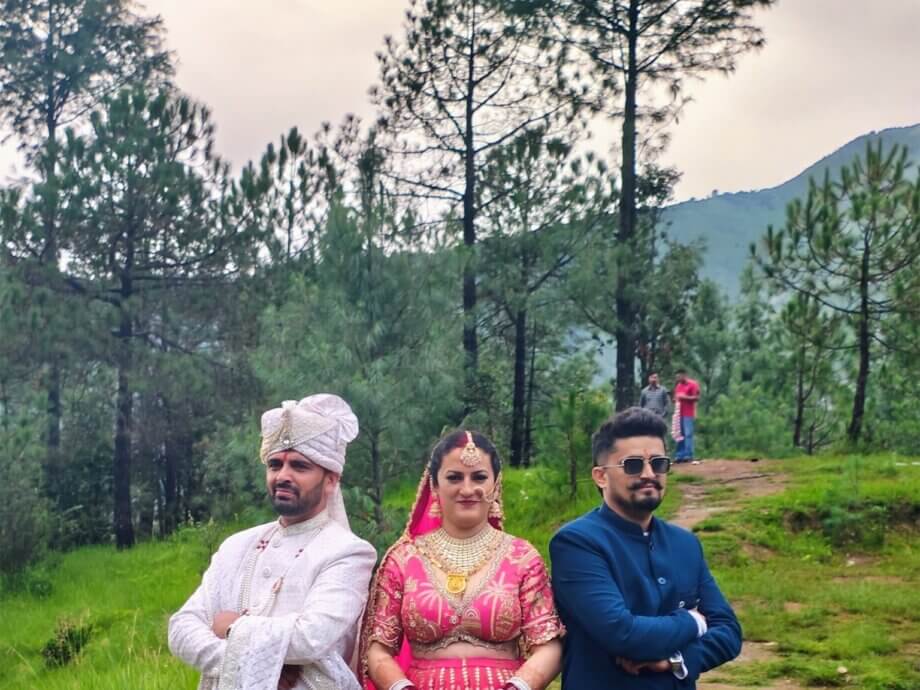The Wedding That Sparked a National Conversation
In July 2025, the quiet Himalayan village of Shillai in Himachal Pradesh’s Sirmaur district became the center of national attention. Hundreds gathered for a wedding that, while ordinary for locals, was extraordinary to the rest of India: Sunita Chauhan married not one, but two brothers—Pradeep and Kapil Negi—following the ancient polyandrous tradition of the Hatti tribe. The three-day celebration, filled with folk songs, drumbeats, and community rituals, revived public debate about a practice that is both centuries old and increasingly rare.
Sunita, a highly educated woman from Kunhat village, and her husbands emphasized that their union was a joint decision, made without coercion. “We are proud of our tradition,” Pradeep, a government worker, told reporters. Kapil, who works abroad, echoed the sentiment, highlighting the support, stability, and love that their arrangement provides. The family declined further media interaction, underscoring that, for them, this was a private matter rooted in cultural heritage.
What Is Polyandry and Why Does It Exist Here?
Polyandry is the practice of a woman marrying multiple men, typically brothers—a system known as fraternal polyandry. Among the Hatti tribe, this tradition is called Jodidara or Jajda. While polyandry is rare globally, it has deep roots in the Himalayan regions of India, Nepal, and Tibet. In the Hatti community, which numbers around 300,000 people across 450 villages in Himachal Pradesh and neighboring Uttarakhand, polyandry was once common and is still recognized under Himachal Pradesh’s revenue laws.
The origins of this practice are both practical and mythological. Locals often cite the Hindu epic Mahabharata, where Draupadi marries the five Pandava brothers, as a precedent. The Hattis call their custom Draupadi Vivah or Pandav Pratha, seeing themselves as descendants of the Pandavas. But the real drivers are economic and social: in the steep, fragmented hills of the Himalayas, land is scarce and difficult to cultivate. If each brother married separately, ancestral land would be divided into ever-smaller plots, threatening the family’s survival. Polyandry keeps landholdings intact, maintains joint family structures, and ensures economic stability in a resource-scarce environment.
As Kundan Singh Shastri, general secretary of the Kendriya Hatti Samiti, explained, “This tradition was invented thousands of years ago to save a family’s agricultural land from further division.” The system also fosters brotherhood and mutual understanding, as brothers share not only a wife but also responsibilities and resources.
How Does Polyandry Work in Practice?
In a typical Hatti polyandrous marriage, the wife is socially married to the eldest brother but also becomes the wife of his siblings. The arrangement is formalized in a public ceremony, with rituals such as the Seenj—where a priest chants mantras, sprinkles holy water, and offers jaggery for blessings and harmony. The bride is escorted to the groom’s village in a procession, and the marriage is celebrated with music, dance, and feasting.
Within the household, intimacy and daily life are managed by mutual agreement. According to research by Y.S. Parmar, Himachal Pradesh’s first Chief Minister and a scholar of Himalayan polyandry, the wife typically decides how her time is distributed among the husbands. In some families, a cap or shoe placed outside the room signals which husband she is with, though in poorer households, all may sleep in the same room. Children are considered the shared responsibility of all brothers, though the eldest is usually listed as the father in official records. The wife manages the household, farm work, and family affairs, sometimes requesting another woman join the household if the workload is too great—she then becomes wife to all brothers as well.
Community members assert that this system promotes unity and reduces jealousy, as long as affection and responsibilities are shared equally. Disputes, when they arise, are typically resolved within the community rather than through formal legal channels.
Legal Status: Tradition Versus Modern Law
Polyandry is not recognized under the Hindu Marriage Act of 1955, which mandates monogamy for Hindus. However, Indian law allows for the protection of tribal customs and traditions, and the Himachal Pradesh High Court has upheld the practice among the Hatti tribe under the so-called Jodidar Law. Revenue records in the state recognize polyandrous unions, and children born from such marriages are adopted under Wajib-ul-Arz, a record of village customs, which gives the practice a form of legal sanctity.
The Hatti community was granted Scheduled Tribe status by Parliament in 2022, partly to protect customs like Jodidara. Still, the legal landscape is complex. While polyandry is technically illegal for most Indians, tribal communities like the Hattis are allowed to continue their traditions under special legal exemptions. This has led to a situation where polyandrous marriages are socially and informally recognized in tribal areas, even as they remain outside the mainstream legal framework.
Changing Attitudes and the Decline of Polyandry
Despite its deep roots, polyandry is in sharp decline. Education, economic development, urban migration, and exposure to modern values have all contributed to changing attitudes. Many younger Hatti men and women now prefer monogamy, and polyandrous marriages are increasingly conducted quietly or not at all. In the past decade, fewer than 50 such weddings have been reported in the region.
Women like Sunila Devi and Meena Devi, who are married to multiple brothers, acknowledge the emotional and physical challenges of the arrangement. Both say they do not want their children to continue the tradition. As Meena put it, “We did it for survival, but our children should have better opportunities.”
Village elders and community leaders recognize that the tradition is fading, but some still urge its continuation to maintain family unity and protect small landholdings. In about 150 villages in the Trans-Giri area, polyandry remains accepted, though often practiced discreetly.
Consent, Gender, and Social Debate
The recent Shillai wedding was notable not just for its adherence to tradition, but for the explicit language of consent and equality used by the participants. Sunita Chauhan publicly stated that her marriage was her choice, based on mutual commitment and care. The brothers emphasized sensitivity, mutual respect, and emotional balance. This modern framing marks a shift in how relationships are understood in tribal communities, with consent now being openly asserted.
However, the issue of consent is complex. While some women insist they were not coerced, others recall being pressured by family or economic necessity. A woman in her sixties recounted being compelled to marry two brothers to avoid dividing property, describing it as pressure rather than force. Gender divides persist, with boys’ births celebrated and girls’ births often overlooked. Critics, including former chief minister Y.S. Parmar, have raised concerns about women’s rights and autonomy within the system, even as some compare polyandry to modern live-in relationships.
The public nature of the Shillai wedding and its viral spread on social media have sparked debate about tradition, marriage, gender, and legal norms. In a country where monogamous Hindu marriage is the legal and moral standard, polyandrous unions challenge singular views of Indian family life and raise questions about the capacity of laws to accommodate diverse forms of love and kinship.
Polyandry Beyond the Hatti Tribe
The Hatti are not the only Himalayan community to practice polyandry. Similar traditions exist among the Kinnauris in Himachal Pradesh, the Jaunsar-Bawar region of Uttarakhand, and in parts of Nepal and Tibet. In all these regions, the practice arose as a pragmatic response to the challenges of mountain agriculture, limited resources, and the need to maintain joint family structures. Anthropologists note that polyandry also acts as a form of population control, limiting the number of children and conserving resources.
Over time, legal changes and economic development have led to the decline of polyandry across the Himalayas. In India, inheritance laws now require equal property division among male siblings, further reducing the incentive for joint marriages. Still, in some remote villages, the tradition persists, protected by customary law and community consensus.
Rituals, Community, and the Meaning of Marriage
Polyandrous weddings in the Hatti community are elaborate affairs, blending ancient rituals with local customs. The Jajda ceremony involves the bride arriving in a festive procession, followed by the Seenj ritual at the groom’s residence. A priest chants mantras, sprinkles holy water, and offers jaggery for blessings and harmony. The marriage is then celebrated with music, dance, and communal feasting, reinforcing the bonds of kinship and community.
For many Hattis, polyandry is not just a marriage arrangement but a symbol of unity, shared responsibility, and cultural pride. As Kapil Negi explained, “We are ensuring support, stability, and love for our wife as a united family.” The tradition is seen as a way to maintain harmony, prevent disputes, and ensure that no woman is left widowed or unsupported.
Controversy and the Future of Polyandry
The future of polyandry in Himachal Pradesh is uncertain. While some community members and leaders advocate for its preservation as a vital part of cultural heritage, others see it as an outdated practice incompatible with modern values and women’s rights. The legal ambiguity surrounding polyandry adds to the complexity, as does the tension between tradition and individual autonomy.
As education and economic opportunities expand, more young people are choosing monogamous marriages and moving to cities. Polyandrous unions are now rare and often conducted discreetly. Yet, for those who continue the tradition, it remains a source of identity and resilience in a rapidly changing world.
The Shillai wedding, with its emphasis on consent and mutual respect, may signal a new chapter in the story of polyandry—one where tradition and modernity coexist, and where the voices of women and men shape the future of their community.
In Summary
- Polyandry, the practice of a woman marrying multiple brothers, is an ancient tradition among Himachal Pradesh’s Hatti tribe, known locally as Jodidara or Jajda.
- The custom originated to prevent division of scarce land, maintain joint family structures, and ensure economic stability in the Himalayan region.
- Recent high-profile weddings, like that of Sunita Chauhan and the Negi brothers, have revived national debate about the practice, consent, and gender roles.
- Polyandry is recognized under Himachal Pradesh’s revenue laws and protected for tribal communities, but is not permitted under general Indian law.
- The tradition is in decline due to education, economic development, and changing social attitudes, though it remains a source of cultural pride for some.
- Consent and autonomy are increasingly emphasized in modern polyandrous marriages, but questions about women’s rights and social pressure persist.
- The future of polyandry in the Hatti community is uncertain, balancing between cultural heritage and the forces of modernization.




